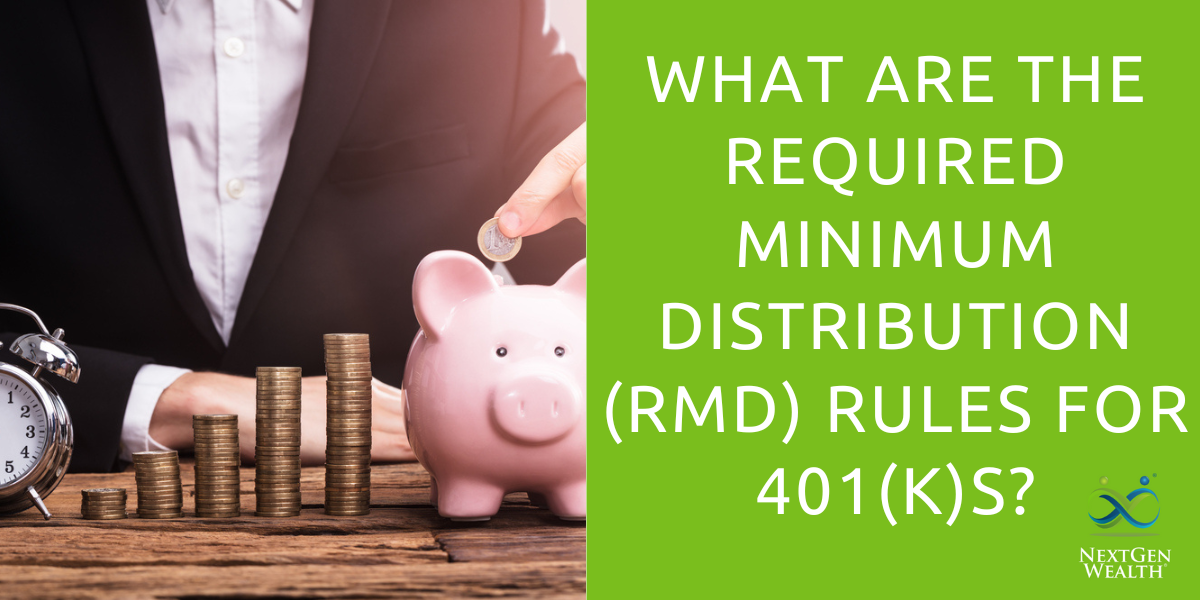What are the Required Minimum Distribution (RMD) rules for 401(k)s?
 This post was last updated on July 24, 2024, to reflect all updated information and best serve your needs.
This post was last updated on July 24, 2024, to reflect all updated information and best serve your needs.
Retirement accounts grow from pre-tax (deductible) contributions during employment. During retirement, account withdrawals, or distributions, are then taxed as ordinary income. To many entering retirement, it would make sense to let these accounts sit, accruing tax-deferred value to further build their savings and/or inheritance to pass on.
The IRS understood this possibility and established required minimum distribution (RMD) rules to prevent account holders from circumventing their tax liability. These rules require account holders to start making annual withdrawals from their retirement accounts when they turn 73 years old.
As an essential part of ensuring a comfortable retirement, understanding how RMDs will affect your 401(k) account can help you strategically plan your savings and investments. Let's talk about how to RMDs might affect your 401k and what to do about it.
What Accounts Have Required Minimum Distributions?
A 401(k) account is an employer-sponsored retirement account that allows for tax-deductible contributions, often with employer matching. The account grows through the investment you choose. Contributions are not reduced by taxes, so more money is put in to grow.
However, the IRS needs to tax income at some point. If they don't take tax on the front end, they'll take it when you start withdrawing distributions in retirement. Like 401(k)s, the following accounts are subject to RMDs to ensure the government receives regular taxes:
- Other employer-sponsored plans, including 403(b), 457(b), and profit-sharing plans
- Traditional IRAs
- IRA-based plans, including SIMPLE and Rollover IRAs, SEPs and SARSEPs
Roth IRAs are not subject to RMDs because, unlike the others, the contributions to the plan are taxed.
Note: Per SECURE Act 2.0, starting 01 January, 2024, Roth designated employer accounts like Roth 401k's will no longer be subject to RMDs.
When Does the RMD for My 401(k) Start?
The Setting Every Community Up for Retirement Enhancement (SECURE) Act was signed in 2019. Before it was enacted, the first distribution had to be taken by April 1st the year after you turned 70 ½ years old.
The SECURE Act changed the threshold to 72 years old. And then SECURE Act 2.0 changed the starting age again to 73 (age 75 starting in 2033). If you turn 73 in 2023, your first RMD needs to be taken out by April 1, 2024. After that, an RMD would need to be taken by December 31 each year.
Waiting too long to take your first distribution may put you at a tax disadvantage. The initial RMD has to be withdrawn by April 1st, while the second is due on December 31 that same year. Taking both in the same year could result in a higher reported income and potentially a higher tax bill.
RMD Exceptions and Extensions for 401(k) Accounts
Unlike IRAs and IRA-based plans, you may be able to postpone your RMDs on an employer-sponsored 401(k). If you still work for the company sponsoring the 401(k) account, you will not have to take your first distribution when you turn 73. If you leave the company after turning 73 years old, you will have to begin RMDs immediately.
You must confirm the details of your company’s 401(k) plan to make sure it allows RMD delays, as there are exceptions. Furthermore, if you own at least 5 percent of the business, you will still have to begin distributions after 73 whether you retire or not.
Discuss the consequences of timing your RMD with a financial professional. Depending on your goals, you may be able to delay making distributions without suffering tax penalties.
CARES Act
The Coronavirus Aid, Relief, and Economic Security (CARES) Act stopped the 2020 required minimum distributions because of COVID. The waiver of RMDs only applied in the year 2020, so this no longer applies.
How Is the RMD from My 401(k) Calculated?
The required minimum distribution for 401(k)s depends on the account’s year-end balance and your age. To calculate your 2023 RMD, you use your age and 401(k) account balance on December 31, 2022.
In the RMD calculation, a life expectancy factor is applied to each year of age. Your total 401(k) balance is divided by the factor to find your RMD for the year. The IRS updates two tables, defined by your unique circumstances, that provide the factor to make the calculation:
- Joint and Last Survivor Table: Use this when a spouse is a 401(k)’s only beneficiary and he/she is over 10 years younger than you.
- Uniform Lifetime Table: Use this table when a spouse is not a 401(k)’s only beneficiary or they are under 10 years younger than you. This is the most common situation.
Let’s say you are 75 years old with a 401(k) worth $200,000 on December 31.
According to the Uniform Lifetime Table, your age has a factor of 24.6. The equation would be 200,000/24.6 to produce your RMD of $8,130 for the year. The IRS would then tax that amount at the appropriate income tax rate.
The RMD is just a lower limit for your distribution, and you are welcome to take more out at one time. However, doing so could move you up a tax bracket and into a larger bill. Also, the excess money in a larger withdrawal cannot go toward a later year’s RMD.
What Are the Rules If I Inherit a 401(k)?
Inherited 401(k) accounts also carry required minimum distributions. However, the particular requirements for how they are to be taken out can vary depending on whether the beneficiary is a spouse or non-spouse. Typically, the beneficiary is automatically the spouse, but if you are single, your 401(k) can go to your children or other relatives.
When you acquire a 401(k) from your spouse, you can either roll it over to your own retirement account (401(k) or IRA) or into an inherited IRA. Inherited IRAs have RMDs based on a third IRS table, the Single Life Expectancy Table.
The SECURE Act
The SECURE Act also affected estate plans. Prior to its passage, if you inherited a 401(k) from a non-spouse, the assets were rolled into an inherited IRA, which had to be withdrawn over a 5-year period.
The new law changed this to a 10-year distribution period. There are exceptions, however, for minor children and those with disabilities or chronic illnesses.
Understanding the details of the 401(k) plan is crucial, as some companies have plan-specific rules that could limit how and when distributions are pulled.
Additional Changes from the IRS
In July 2024, the IRS issued final regulations regarding RMDs on inherited retirement accounts among other things. Specifically, they clarified that "non-eligible" beneficiaries must take annual distributions. Before, it was assumed you just had to deplete the account within ten years following the death of the original account holder.
There are many other nuances regarding which beneficiaries take what RMDs. If there are multiple beneficiaries, you'll need to ensure you're in compliance so you're not hit with a penalty.
Also, if 100% of the balance is in a Roth account, no annual distributions are necessary. Therefore, if you want the most flexibility, you should consider rolling all Roth account balances into a Roth IRA. This would allow you to keep the money invested in a Roth account until the end of the 10-year period.
What Happens If I Don’t Take My Scheduled RMD?
The standard penalty for not taking your RMD by the deadline is a 25% excise tax on the money you failed to withdraw. The account holder must file IRS Form 5329 with their federal tax return to make up the difference. This form, with an explanation letter, can also be used to dismiss the penalty if the failure was through reasonable error and appropriate steps are taken to rectify it.
Aslo, If you correct the error in "timely manner," then your penalty should be reduced to 10%. This has to be completed within the "correction window" which starts the day the RMD was due until one of the following:
- The date the notice of deficiency is mailed to you
- The date on which the tax is assessed
- The end of the second taxable year after the tax is imposed
Can I Avoid an RMD on My 401(k)?
You may not be able to completely avoid RMDs, but you might not have to either. A common strategy is the use of Roth conversions. You may also be able to take a qualified charitable contribution (QCD) as an RMD instead.
Ultimately, you'll probably want to take some distributions regardless - the purpose of saving for retirement is spending the money in retirment. If we can get your RMDs to be about what you'll want to withdraw as income, you're in good shape. RMDs aren't as big of an issue until you start having to withdraw significantly more than you need.
Talk to a Financial Advisor
Smart retirement strategies begin with a discussion with an experienced financial advisor. The RMD rules for 401(k)s are complex, and various state laws and company plan requirements add even more considerations. An accurate assessment of your financial goals can help you identify the best investment options and avoid unexpected drawbacks.
Required minimum distributions are a small yet consequential component of retirement preparation. At NextGen Wealth, we take a comprehensive approach in assessing your financial needs. We work with you to achieve your retirement goals. Contact us for a free financial assessment and discuss how we can help you maximize your retirement.



